Related Research Articles
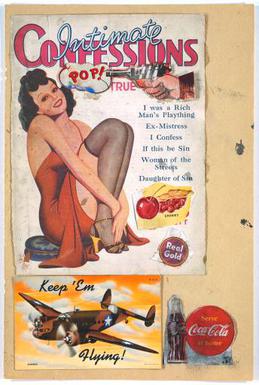
Pop art is an art movement that emerged in the United Kingdom and the United States during the mid- to late-1950s. The movement presented a challenge to traditions of fine art by including imagery from popular and mass culture, such as advertising, comic books and mundane mass-produced objects. One of its aims is to use images of popular culture in art, emphasizing the banal or kitschy elements of any culture, most often through the use of irony. It is also associated with the artists' use of mechanical means of reproduction or rendering techniques. In pop art, material is sometimes visually removed from its known context, isolated, or combined with unrelated material.

The Institute of Contemporary Arts (ICA) is an artistic and cultural centre on The Mall in London, just off Trafalgar Square. Located within Nash House, part of Carlton House Terrace, near the Duke of York Steps and Admiralty Arch, the ICA contains galleries, a theatre, two cinemas, a bookshop and a bar.

Archigram was an avant-garde British architectural group whose unbuilt projects and media-savvy provocations "spawned the most influential architectural movement of the 1960's," according to Peter Cook, in the Princeton Architectural Press study Archigram (1999). Neofuturistic, anti-heroic, and pro-consumerist, the group drew inspiration from technology in order to create a new reality that was expressed through hypothetical projects, i.e., its buildings were never built, although the group did produce what the architectural historian Charles Jencks called "a series of monumental objects (one hesitates in calling them buildings since most of them moved, grew, flew, walked, burrowed or just sank under the water." The works of Archigram had a neofuturistic slant, influenced by Antonio Sant'Elia's works. Buckminster Fuller and Yona Friedman were also important sources of inspiration.

Richard William Hamilton CH was an English painter and collage artist. His 1955 exhibition Man, Machine and Motion and his 1956 collage Just what is it that makes today's homes so different, so appealing?, produced for the This Is Tomorrow exhibition of the Independent Group in London, are considered by critics and historians to be among the earliest works of pop art. A major retrospective of his work was at Tate Modern until May 2014.
The Independent Group (IG) met at the Institute of Contemporary Arts (ICA) in London, England, from 1952 to 1955. The IG consisted of painters, sculptors, architects, writers and critics who wanted to challenge prevailing modernist approaches to culture. They introduced mass culture into debates about high culture, re-evaluated modernism and created the "as found" or "found object" aesthetic. The subject of renewed interest in a post-disciplinary age, the IG was the topic of a two-day, international conference at the Tate Britain in March 2007. The Independent Group is regarded as the precursor to the Pop Art movement in Britain.
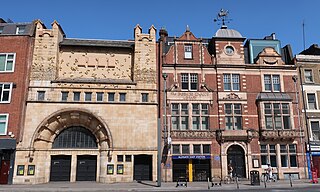
The Whitechapel Gallery is a public art gallery in Whitechapel on the north side of Whitechapel High Street, in the London Borough of Tower Hamlets. The original building, designed by Charles Harrison Townsend, opened in 1901 as one of the first publicly funded galleries for temporary exhibitions in London. The building is a notable example of the British Modern Style. In 2009 the gallery approximately doubled in size by incorporating the adjacent former Passmore Edwards library building. It exhibits the work of contemporary artists and organizes retrospective exhibitions and other art shows.
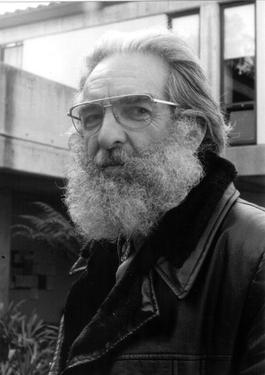
Peter Reyner Banham Hon. FRIBA was an English architectural critic and writer best known for his theoretical treatise Theory and Design in the First Machine Age (1960) and for his 1971 book Los Angeles: The Architecture of Four Ecologies. In the latter he categorized the Los Angeles experience into four ecological models and explored the distinct architectural cultures of each. A frequent visitor to the United States from the early 1960s, he relocated there in 1976.
Lawrence Reginald Alloway was an English art critic and curator who worked in the United States from 1961. In the 1950s, he was a leading member of the Independent Group in the UK and in the 1960s was an influential writer and curator in the US. He first used the term "mass popular art" in the mid-1950s and used the term "Pop Art" in the 1960s to indicate that art has a basis in the popular culture of its day and takes from it a faith in the power of images. From 1954 until his death in 1990, he was married to the painter Sylvia Sleigh.

Neo-futurism is a late-20th to early-21st-century movement in the arts, design, and architecture.
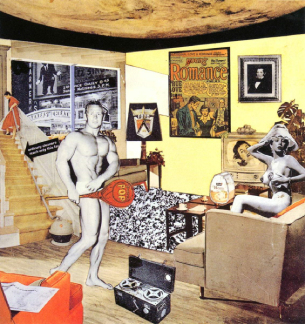
Just what is it that makes today's homes so different, so appealing? is a collage by English artist Richard Hamilton. It measures 10.25 in (260 mm) × 9.75 in (248 mm). The work is now in the collection of the Kunsthalle Tübingen, Tübingen, Germany. It was the first work of pop art to achieve iconic status.
Megastructure is an architectural and urban concept of the post-war era, which envisions a city or an urban form that could be encased in a massive single human-made structure or a relatively small number of interconnected structures. In a megastructural project, orders and hierarchies are created with large and permanent structures supporting small and transitional ones.
John McHale was a British artist, art theorist, sociologist and future studies searcher. He was a member of the Independent Group, a British movement that originated pop art which grew out of an interest in American mass culture and post–World War II technologies.

The Institute of Contemporary Art (ICA) is an art museum and exhibition space located in Boston, Massachusetts, United States. The museum was founded as the Boston Museum of Modern Art in 1936. Since then it has gone through multiple name changes as well as moving its galleries and support spaces over 13 times. Its current home was built in 2006 in the South Boston Seaport District and designed by architects Diller Scofidio + Renfro.
Frank Cordell was a British composer, arranger and conductor, who was active with the Institute of Contemporary Arts. He also composed music under the name Frank Meilleur or Meillear.
J D H Catleugh was a British abstract artist whose career began in the 1950s and continued until his death in 2009.
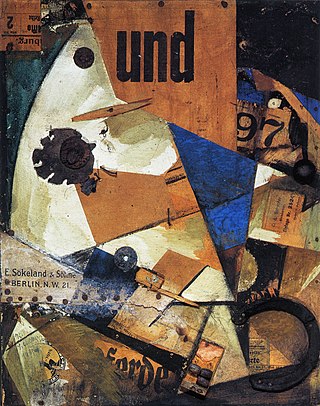
Collage is a technique of art creation, primarily used in the visual arts, but in music too, by which art results from an assemblage of different forms, thus creating a new whole.

John Harold Westgarth Voelcker was an English architect. A member of the Team 10 group of architects, he ran a small rural practice before his appointment first Professor of Architecture at the University of Glasgow.

Magda Cordell McHale was a Hungarian artist, futurist, and educator. She was a founding member of the Independent Group which was a British movement that originated Pop Art which grew out of a fascination with American mass culture and post-WWII technologies. Later, she was a faculty member in the University at Buffalo School of Architecture & Planning.

Theo Crosby was an architect, editor, writer and sculptor, engaged with major developments in design across four decades. He was also an early vocal critic of modern urbanism. He is best remembered as a founding partner of the international design partnership Pentagram, and as architect for the reconstruction of Shakespeare's Globe in London. However, his role as éminence grise in British architecture and design from 1950 to 1990 helped effect much broader changes. Crosby's archive is located at the University of Brighton Design Archives.
Nigel Graeme Henderson (1 April 1917 – 15 May 1985) was an English documentary artist, and photographer.
References
- ↑ A photo of the Dazzle Panels produced by John McHale is provided on page 139 of The Independent Group by Robbins, and a description is provided in Warholstars
- ↑ A good deal of the visual material was provided by John McHale when he returned in late May from his academic year-long fellowship at Yale page 139, David Robbins, Aesthetics of Plenty, MIT Press, ISBN 0-262-18139-8
- ↑ Projectors, gramophone motors for moving the Duchamp rotoreliefs, film posters, and probably the juke box, were supplied by Frank Cordell, Robbins page 139
- ↑ "026TT-1956". 21 November 2008. Archived from the original on 21 November 2008. Retrieved 29 May 2023.
- ↑ "025TT-1956". 21 November 2008. Archived from the original on 21 November 2008. Retrieved 29 May 2023.
- ↑ John-Paul Stonard (2007), ""Pop in the Age of Boom: Richard Hamilton's 'Just what is it that makes today's homes so different, so appealing?'"" (PDF). Archived from the original (PDF) on 25 February 2009., The Burlington Magazine , September 2007
- ↑ Highmore, Ben. "Rough Poetry: ‘Patio and Pavilion’ Revisited." Oxford Art Journal 29, no. 2 (June 2006): 269-290.
- ↑ "029Tt-1956". Thisistomorrow2.com. Archived from the original on 21 November 2008. Retrieved 13 January 2022.
- ↑ "033Tt-1956". Thisistomorrow2.com. Archived from the original on 21 November 2008. Retrieved 13 January 2022.
- ↑ "Tate Britain | Past Exhibitions | William Turnbull". Tate.org.uk. Archived from the original on 22 June 2008. Retrieved 13 January 2022.
- ↑ [ dead link ]
- ↑ [ dead link ]